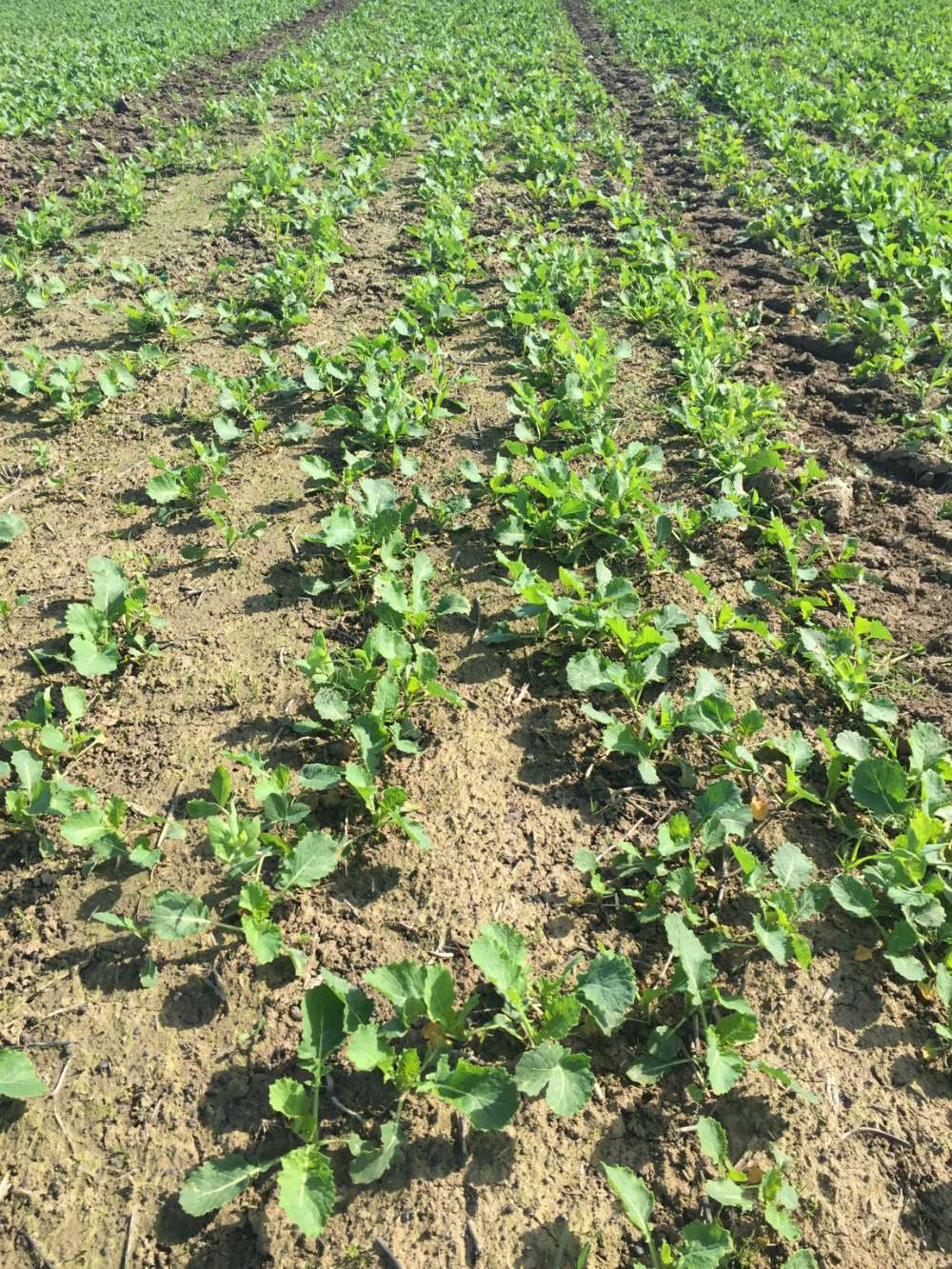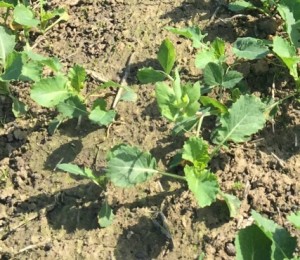A quandary of many grain farmers is knowing that the rotation to a pulse crop is a good thing for the soil and farming system, but that this choice has often come with an increased risk associated with these crops. This is when some farmers decide to be innovative to solve such problems – as is the case with Nick Shady on his farm near Lismore in Victoria, Australia (West of Melbourne). Nick has moved to low rates of liquid fertilizer and has begun to experiment by combining a pulse crop with another of his grain crops.
This has led Nick to discover the world of companion cropping or intercropping, with his crop that he aptly calls ‘Peaola’ (a mix of field peas and canola). His ideas developed after he planted a field pea crop quite late (as planting was delayed due to wet weather); in a season that rapidly turned dry. The crop that resulted was not worth harvesting, but was rather treated as a brown manure crop and then worked into the soil prior to summer for the associated advantages.
At that time, Nick was concerned about the risk of the high upfront input costs of planting a pulse crop among increasingly variable seasons. Nick was after a lower cost of production option and wanted to make every paddock for each season profitable. He is prepared to forgo the extreme financial cream off the top end in the really good years to ensure production every year. After this failure of the field pea crop, Nick then started questioning if he could incorporate the pulse crop into one of his other grain crops to reduce the risk associated with the stand alone pulse production and to see what benefits if any were measurable. This is how Nick’s peaola crop came about. [private]This allowed Nick to include the pulse crop in his three year rotation, but without devoting a whole season to a crop that had traditionally proved relatively high risk due to weather concerns and variable returns.
The following season after the field pea failure, Nick planted his first ‘peaola crop, which was 2013.
How to plant an inter-row crop.
To date, Nick has planted his peaola in two passes and this season planted field peas in furrow as would normally be done and then spread the canola out the back of the air seeder and pressed in with a roller over the top. Ideally it would be good to separate by using the interrow to plant, although the trash flow could be an issue. There is a challenge in getting the right balance with regard to sowing dates. He has been planting around the first week of June – which is a few weeks later than ideal for canola, but he is hesitant to go much earlier in case the peas grow too much bulk and overtake the canola . The canola sowing rate remains the same, while the field pea rate is dropped by over half (45kg/ha versus 100-120kg/ha in a pure crop). Nick chooses shorter season varieties of canola to help with the management of the crops.
The planting technique in other crops is something that Nick says he would like to develop further – he wonders about spreading the peas out the front of the seeder when sowing a cereal crop and having them covered by the soil toss from the tynes . There is always much to experiment with when a new concept is being tried.
It is relatively early days for Nick in terms of financial outcomes. The best peaola crop of Nicks in 2013 yielded around 3t/ha – about 2t of canola and about 1t of field peas. The mix is then graded after harvest, with the peas having been an easily marketable grain,(as they haven’t been in dirt, but rather supported by the canola plants) with markets as sheep feed and for milling in his region. The peas seem to nodulate well early on and do really well until the canola begins to elongate, at which point it seems to then dominate. (Nick believes that the canola uses the nitrogen from the peas while growing).
In the first year of two comparison paddocks side by side, the peaola yielded 2.7t/ha – exactly the same as the pure canola at 2.7t/ha. The question then becomes what is canola worth, versus field peas. But it is not only about this; as I mentioned Nick is thinking past just this crop. What will be the effects of the pulse inclusion on the following crop?
To help assess this, Nick has set up two blocks that he is treating the same, bar the crop choice. This is what is rolling out so far.
|
|
Paddock 1 – 42 Ha |
Paddock 2 – 44 Ha |
||
|
|
Crop |
Yield |
Crop |
Yield |
|
2012 |
Barley |
3.7t/ha |
Field pea failure (brown manured) |
0 |
|
2013 |
Peaola (field peas and canola) |
Total 2.7t/ha (Canola 1.8/ha Field peas 0.9t/ha) |
Canola |
2.7t/ha |
|
2014 |
Wheat |
3.2t/ha |
Wheat |
2.9t/ha |
|
2015 |
Barley |
|
Barley |
|
|
2016 plan |
Peaola |
|
Peaola |
|
Note that the oil percentages were the same in the peaola and in the pure canola.
In the 2014 crop, Nick applied just 32kg/ha of nitrogen (70kg/ha urea) to the wheat crops in both blocks mentioned above. This is a relatively low application rate of N for wheat and I wonder what the yield comparison would be if Nick placed higher nitrogen rates on the wheat that didn’t follow the peaola, to reflect more closely what a farmer might realistically do. The point of this however is for Nick to create a system where inputs are reduced and production is profitable every year. Nick is thinking about every year being a winner.
We can see from the results above, there seems to be an advantage from the peaola in the yield and quality as the protein was 0.4% higher in paddock 1 of the following crop of wheat, which has allowed Nick to produce his crop with a reduced nitrogen input. Now this is not a fully replicated trial by any means, but these sorts of demonstrations are great to do on our own farms under our own conditions to test the very things that we are interested in. After all, many of us have different farm business goals from one another.
Benefits to Companion or Intercropping
Early season (around 6 weeks) canola plant damage is common in parts of Victoria due to slugs and birds – specifically the brown lark, which damages establishing plants; resulting in significant loss of plants and yield. In an unexpected advantage of the pea and canola mix, Nick reported less bird attack on his peaola crop. He wondered if the field peas provided a green bridge that possibly deterred the brown larks from the crop, protecting it from damage. I wonder whether this is a physical thing (like the advantage stubble has with deterring aphids from faba beans) or some influence of the lower nitrogen rates and more balanced nutrient makeup. The peas and canola would support different soil microbiology – potentially making different nutrients available to both plant types. Does the addition of the peas change this balance, resulting in a healthier plant? Could this influence the birds’ behaviour the way that insects are influenced by the varying ultraviolet emissions from healthy and unhealthy plants? I have written about this previously here http://www.theconsciousfarmer.com/plant-health-sugar-levels/ . Birds do also possess such infrared eyesight. Could they also be selective in the plants they attack?
Conclusion
Nick is persisting with his peaola and is optimistic that it can help him to achieve his goal of making every year a profitable winner – even through challenging seasons. What Nick is doing is a wonderful example of someone thinking outside the box and questioning how he can incorporate the things that he knows are an advantage for the soil and farm system into his current programme. That is, diversity in plants – to support diversity in soil microbiology – to support healthy plants, whilst receiving a reliable and more consistent return year on year.
Which crops do you think would suit your farm system and environment?


